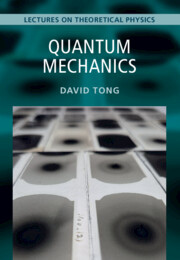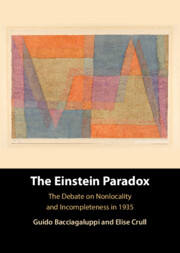Refine search
Actions for selected content:
66 results
Chapter 2 - An Entangled History of the Peloponnesian War
-
-
- Book:
- Reassessing the Peloponnesian War
- Published online:
- 21 August 2025
- Print publication:
- 04 September 2025, pp 15-41
-
- Chapter
- Export citation

Quantum Mechanics
- Lectures on Theoretical Physics
-
- Published online:
- 27 June 2025
- Print publication:
- 19 June 2025
-
- Textbook
- Export citation
10 - Untangling Entanglement History: Early Quantum Contributions of Chien-Shiung Wu
-
-
- Book:
- Women in the History of Quantum Physics
- Published online:
- 02 July 2025
- Print publication:
- 19 June 2025, pp 277-308
-
- Chapter
- Export citation
Chapter 6 - Timescales of Art as Interacting Processes
- from Part II - Entangled Timescales of Visual Arts
-
- Book:
- A Complex Systems View on the Visual Arts
- Published online:
- 20 March 2025
- Print publication:
- 03 April 2025, pp 115-117
-
- Chapter
- Export citation
6 - Quantum and Classical in Phase Space: Decoherence and the Second Law
- from Part II - Decoherence
-
- Book:
- Decoherence and Quantum Darwinism
- Published online:
- 06 March 2025
- Print publication:
- 13 March 2025, pp 158-190
-
- Chapter
- Export citation
5 - Decoherence, Einselection, and Its Consequences
- from Part II - Decoherence
-
- Book:
- Decoherence and Quantum Darwinism
- Published online:
- 06 March 2025
- Print publication:
- 13 March 2025, pp 109-157
-
- Chapter
- Export citation
3 - Born’s Rule from the Symmetries of Entanglement
- from Part I - Foundations
-
- Book:
- Decoherence and Quantum Darwinism
- Published online:
- 06 March 2025
- Print publication:
- 13 March 2025, pp 44-74
-
- Chapter
- Export citation
Chapter 17 - Quantum Probabilities
- from Part III - Mathematical Theories
-
- Book:
- Looking Ahead
- Published online:
- 20 March 2025
- Print publication:
- 06 March 2025, pp 188-198
-
- Chapter
- Export citation
14 - Brownian Motion: Classical and Semiclassical Entanglement
- from Part IV - Contextual Entanglement in Quantum and Classical Physics
-
- Book:
- Contextual Reinterpretation of Quantum Nonlocality
- Published online:
- 28 November 2024
- Print publication:
- 05 December 2024, pp 165-192
-
- Chapter
- Export citation
Envoi
-
- Book:
- The Einstein Paradox
- Published online:
- 14 November 2024
- Print publication:
- 28 November 2024, pp 351-351
-
- Chapter
- Export citation
3 - Schrödinger on EPR
-
- Book:
- The Einstein Paradox
- Published online:
- 14 November 2024
- Print publication:
- 28 November 2024, pp 52-94
-
- Chapter
- Export citation
11 - The Present Situation in Quantum Mechanics
-
- Book:
- The Einstein Paradox
- Published online:
- 14 November 2024
- Print publication:
- 28 November 2024, pp 175-207
-
- Chapter
- Export citation
1 - Einstein on EPR
-
- Book:
- The Einstein Paradox
- Published online:
- 14 November 2024
- Print publication:
- 28 November 2024, pp 3-35
-
- Chapter
-
- You have access
- Export citation
10 - Discussion of Probability Relations Between Separated Systems
-
- Book:
- The Einstein Paradox
- Published online:
- 14 November 2024
- Print publication:
- 28 November 2024, pp 164-174
-
- Chapter
- Export citation
10 - Contextuality
-
- Book:
- Quantum Models of Cognition and Decision
- Published online:
- 14 November 2024
- Print publication:
- 21 November 2024, pp 285-312
-
- Chapter
- Export citation
3 - Advanced Quantum Probability
-
- Book:
- Quantum Models of Cognition and Decision
- Published online:
- 14 November 2024
- Print publication:
- 21 November 2024, pp 60-96
-
- Chapter
- Export citation

The Einstein Paradox
- The Debate on Nonlocality and Incompleteness in 1935
-
- Published online:
- 14 November 2024
- Print publication:
- 28 November 2024
Chapter 6 - Stargazing in Joyce and Walcott: Navigating Colonial Entanglements with Asterisms
- from Part II - Planets
-
-
- Book:
- Transnationalism in Irish Literature and Culture
- Published online:
- 13 November 2024
- Print publication:
- 14 November 2024, pp 119-134
-
- Chapter
- Export citation
An entangled memoryscape: Holocaust memory on social media
- Part of
-
- Journal:
- Memory, Mind & Media / Volume 3 / 2024
- Published online by Cambridge University Press:
- 24 October 2024, e23
-
- Article
-
- You have access
- Open access
- HTML
- Export citation
1 - Introduction
-
- Book:
- Centaurs and Snake-Kings
- Published online:
- 16 August 2024
- Print publication:
- 25 July 2024, pp 1-23
-
- Chapter
- Export citation
